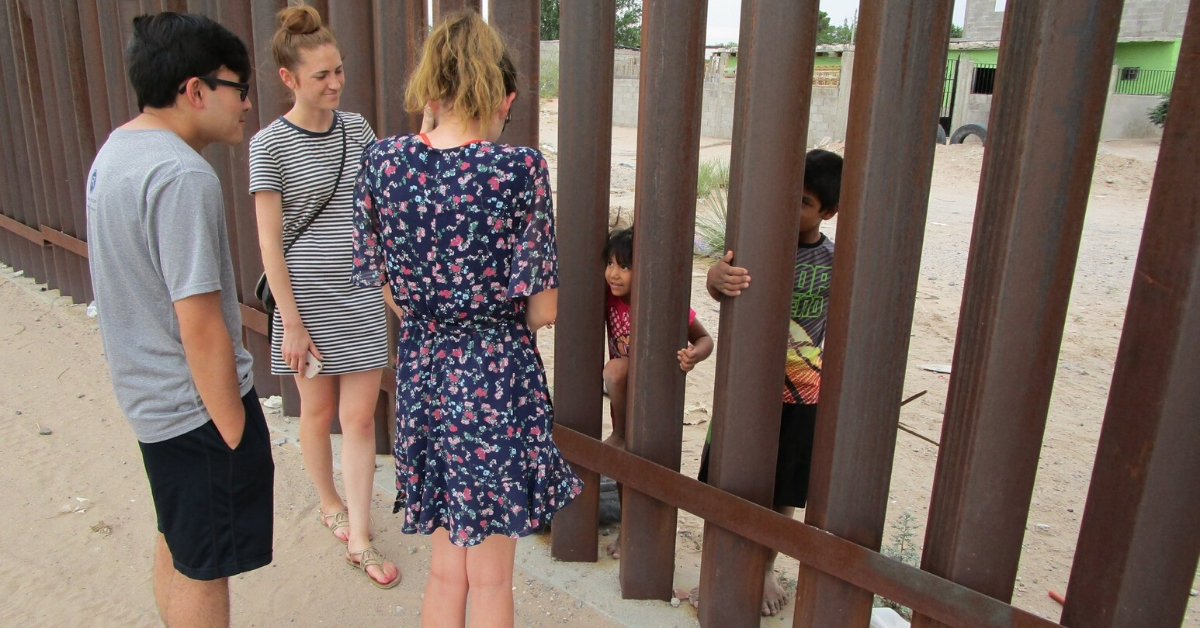
Columban missionaries have been accompanying communities along the US/MX border for over 25 years. Every day we see how border communities are models of hospitality and creative cross-cultural encounter.
But we also see how inhumane immigration enforcement and extreme militarization sow fear, distrust, and trauma in our communities.
While every presidential administration over the past forty years has employed an enforcement-heavy approach to border policy, Trump’s administration has expanded and intensified it. This strategy has had brutal consequences for our migrant sisters and brothers, including deep psychology trauma and death.
As the President’s first term comes to a close, we want to review four of his major border policies: construction of a border wall, family separation, restricting access to asylum, and extreme militarization.
In this article, we will look at construction of a border wall.
The United States first began building a wall on the US/MX border during George H.W. Bush's administration. In 1990, the US Border Patrol erected the first physical barrier in its San Diego sector.
Every president since has authorized the expansion of the border wall, but it wasn’t until the aftermath of the 9/11 terrorist attack that construction escalated.
In 2006, President George W. Bush signed the “Secure Fence Act of 2006,” which authorized and partially funded the construction of 700 miles of fencing. The “Secure Fence Act's” costs were estimated at $6 billion, more than the Customs and Border Protection's (CBP) entire annual discretionary budget of $5.6 billion.
By 2011, the Department of Homeland Security (DHS) had erected 99.5% of the 652 miles of wall originally planned by the legislation.
From the very beginning of his presidential campaign in 2015, then-candidate Trump made additional construction of border wall (and border policy generally) the signature element of his campaign.
In the first few days of his administration in 2017, the President signed an executive order directing the US government to begin constructing wall on federal lands, although lack of funding prevented construction. In March 2018, Congress approved $1.6 billion for new and placement wall and construction was able to begin.
By the end of that year, however, the President announced he would not sign any future funding bills without $5.7 billion for border wall funding. His demand far exceeded the funding level he had previously requested and that Congress had allocated. As a result, the federal government shutdown from December 22, 2018 to January 25, 2019, the longest government shutdown in US history.
The government was finally reopened when the President agreed to a compromise that did include increased funding for the border wall (though not at the level he originally demanded).
Then on February 15, the President declared a national state of emergency. He made this declaration in order to circumvent Congress and take money from other agencies to pay for additional border wall construction. For example, he redirected billions of dollars from the Department of Defense, including money intended for military construction projects.
In February/March and September of 2019, the House and the Senate voted in favor of a resolution rejecting the declaration of a national emergency and both times the President vetoed it. There is not enough support in the Senate to override the President’s veto.
In January 2020, the Washington Post reported that the administration is “considering diverting around $7.2 billion in additional Pentagon funding for border wall construction, five times what Congress authorized.” These kinds of money transfer are in direct violation of Congress’ explicit intent.
Border residents overwhelming reject the border wall, which they believe has a direct impact on businesses, deterring tourism and stifling the economic growth of the region.
The border wall is also a symbol of fear and division. Columbans believe that we must cross divides of all kinds in order to deepen our faith and strengthen the bonds of solidarity to create a more just and peaceful world.
The Catholic experience of mission is defined by cross-cultural exchange, the belief that God speaks to us through the experiences of others, particularly those who are marginalized or living in poverty, and that we should open our hearts to learn from those experiences. As St. Columban puts it: “a life unlike your own can be your teacher.”
In his pastoral letter, Sorrow and Mourning Flee Away, Bishop Mark Seitz of El Paso, TX succinctly summarizes Church teaching by saying that “while countries have a duty to ensure that immigration is orderly and safe, this responsibility can never serve as a pretext to build walls and shut the door to migrants and refugees.”
By shutting the down on migrants and refugees, border walls threaten lives. They create a “bottle neck” forcing migrants to seek safety within the United States by looking for entrance in remote parts of the desert. “The burning sands of our desert are an unmarked grave for too many migrants who have died attempting to cross,” Bishop Seitz continues. “Increased militarization and more walls will only make this journey even more dangerous.”
Instead of building walls, we should enact compassionate border policies. We can expand legal protectionss for those who need them, including women who are fleeing domestic violence, families escaping gang violence, and unaccompanied children. We can invest in upgrades to ports of entry along the border and provide additional scanning technology to better facilitate cross-border movement of people and goods. And we can step up to address the root causes of forced migration and displacement in the first place, so that people can lead safe and dignified lives in their home countries.
*Editor's Note: Download our Border Solidarity Toolkit for a curated list of resources and activities that will help you learn more about US/MX border communities and how you can support them through prayer, education, and action.
Copyright © 2025 Columban Center for Advocacy and Outreach, Washington, D.C.